P.S.A. Fielding & W(B). G. Aston
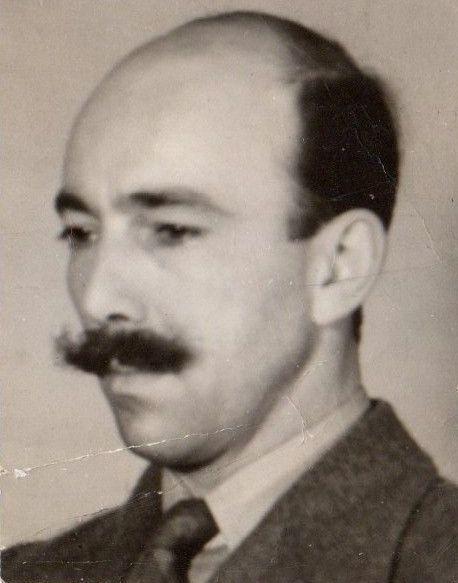
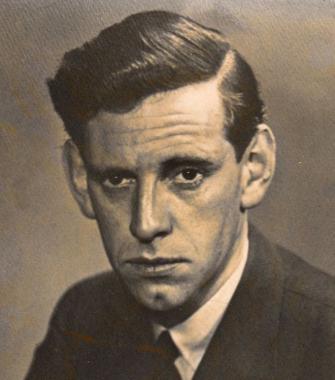
F/Lt Peter Samuel Ashton Fielding Sqn Ldr William (Billy) George Aston, D.F.C.
Source B.G. Aston Logbook © Marc Aston
A l'occasion d'une visite chez mes beau-parents, à Domfront-en-Champagne (72), je découvrais dans le village une plaque commémorative en hommage à Peter Samuel Ashton Fielding, aviateur anglais abattu à Domfront-en-Champagne le 29 janvier 1944.
Once I was visiting the parents of my friend, at Domfront-en-Champagne (Sarthe, France), I discovered in the village a commemorative plaque in tribute to Peter Samuel Ashton Fielding, English aviator shot down and killed in Domfront-en-Champagne on January 29th, 1944.
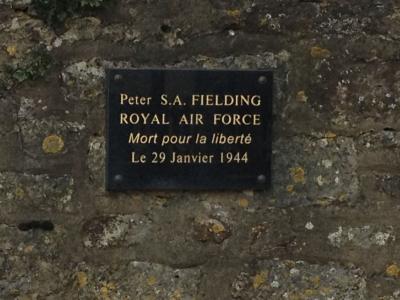
Plaque commemorative, Domfront-en-Champagne (72)
Commemorative plaque, Domfront-en-Champagne, (72 -France)
© Famille Paquet - Paquet Family
Je décidais alors d'entamer des recherches sur cet aviateur : cela commença avec mon beau-père, qui, se souvenant de cet évènement lorsqu'il avait 11 ans, me retrouva des articles de presse locale racontant les investigations de Jacky Emery au sujet de cet avion abattu. A l'aide de ces articles et en discutant sur des forums internet, je découvrait qu'un Mosquito du Sqn 544, piloté par William (Billy) George Aston et avec comme navigateur Peter S.A. Fielding, fut abattu ce 29 janvier 1944 ; le pilote sauta en parachute mais le navigateur fut malheureusement tué.
I then decided to investigate on this aviator : it started with the father of my friend, who remembered quite well this event when he was 11 and who found me local press articles relating the investigations of Jacky Emery about this shot down aircraft. With these articles and thanks to some forums on Internet, I discovered that a Mosquito of Sqn 544, flown by William (Billy) George Aston with the navigator Peter S.A. Fielding, was shot down this January 29th, 1944 ; the pilot jumped in parachute but the navigator was unfortunately killed.
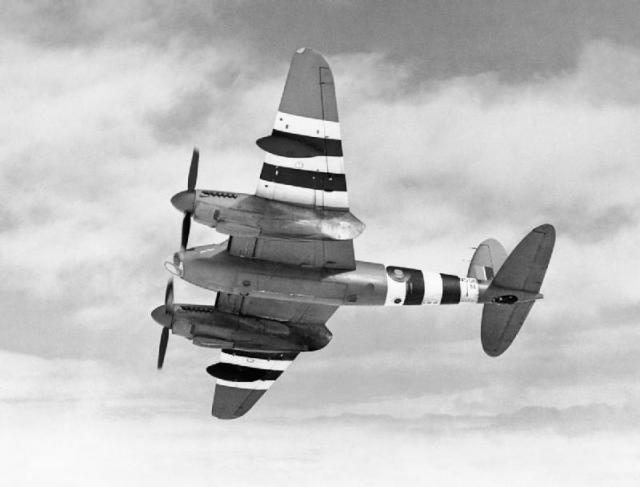
De Havilland Mosquito, PR Mk XVI, Sqn 544, Juillet 1944 - July 1944
© United Kingdom Government - domaine public, public domain
Et puis le 11 juillet 2014, je reçois un email du Canada de Marc Aston, le fils du pilote ayant sauté en parachute : la magie d'internet. Ce dernier me confia de précieuses informations sur la vite de son père et surtout m'envoya des copies du log book de ce dernier, qui fut emprisonné au Stalag Luft 3 après son parachutage. Je décidais donc de consacrer une rubrique à ces deux valeureux aviateurs.
Then on July 11th, 2014, I received an e-mail from Canada from Marc Aston, the son of the pilot who parachuted : the magic of Internet ! He gave me some information on his father and sent me copies of his log book, which informed me he has been imprisoned in the Stalag Luft 3 after his parachuting. I thus decided to open a section dedicated to these two valorous aviators.
Le 29 janvier 1944 - January 24th, 1944
18h35 (heure anglaise) le 29 janvier 1944, un De Havilland Mosquito LR430 PR.IX du Sqn 544 décolle de la base Photography Research Unit de Benson (Oxfordshire) pour une mission de reconnaissance sur la gare de triage du Mans, dans la Sarthe. Il embarque avec lui 6 flash bombes de un million de candélas (bombes servant à éclairer une cible pour la photographier) et une caméra de type K 17.
6:35 pm (English time) on January 29th, 1944, a De Havilland Mosquito LR430 PR.IX of Sqn 544 took off from Photography Research Unit RAF Benson (Oxfordshire) for a mission of reconnaissance over the dispatching railway station at Le Mans, Western france. It was loaded with 6 x million candle power flash bombs and a K 17 type camera.
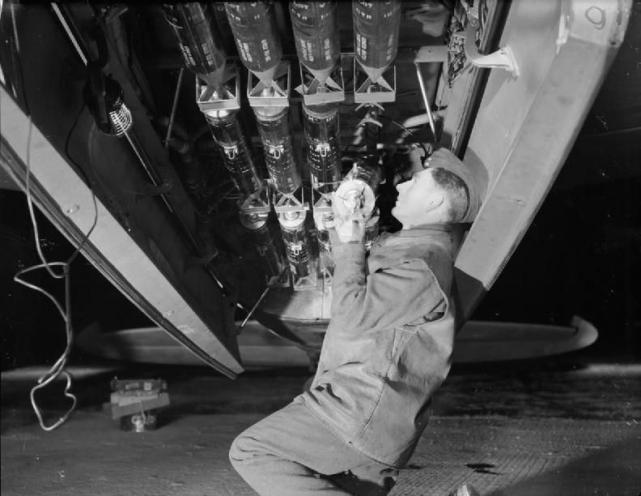
Chargement de flash bombes à bord d'un De Havilland Mosquito, PR Mk XVI, Sqn 130, Melsbroek, Belgique, 1944
Loading flash bombs on board of a De Havilland Mosquito PR M XVI, Sqn 130, Melsbroek, Belgium, 1944
© United Kingdom Government - domaine public, public domain
L'avion grimpe à 30 000 pieds (9 144 m) et met le cap sur Cherbourg, passe la côte à 19h10 à 30 000 pieds et met le cap sur le Mans. A l'approche de la cible, le moteur droit montra des défaillances : le pilote effectua un virage à 360° et commença à descendre à 23 000 pieds vers la cible sur le moteur gauche. Le moteur droit fonctionnait par intermittence. Aston ouvrit la soute à bombes et à ce moment là, l'avion explosa, Le pilote fut projeté hors des débris avec son parachute, avec seulement quelques blessures et brûlures légères. L'explosion pourrait-être due à un tir de la DCA ou par l'explosion d'une flash bombe.
It climbed to 30 000 feet and sat course Cherbourg, crossed coast at 7:10 pm and sat course Le Mans. Whilst approaching the target, the stb engine failed : the pilot completed a 360° turn and started to run up to target at 23 000 feet on port engine. The stb engine was running intermitently. Aston opened the bom doors and suddenly the aircraft exploded. The pilot was blown through his safety straps completely clear of the debris and sustained only minor injuries and burns. The cause of the explosion could have been a direct shot of the flak or the explosion of one of the flash bombs.
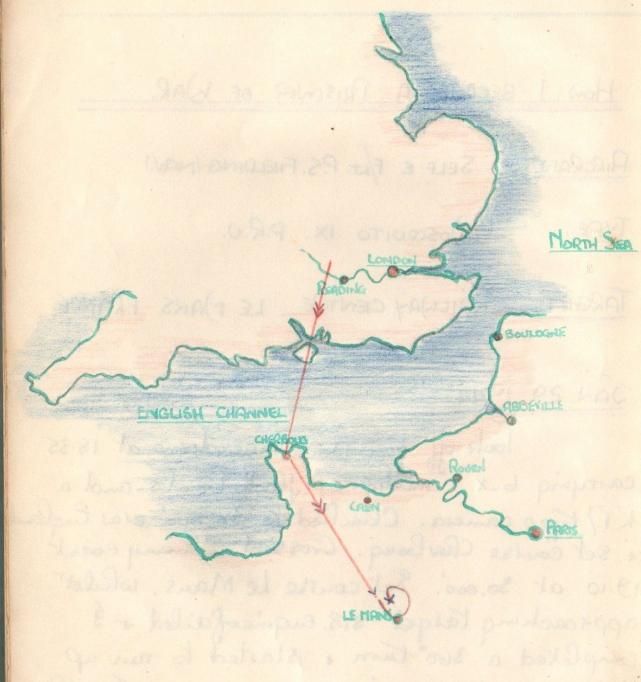
Parcours du Mosquito le 29.01.1944 - The route of the Mosquito, on January 29th, 1944
Source B.G. Aston Logbook © Marc Aston
Aston atterrit à environ 7 kms au Nord-Est de Domfront-en-Champagne, à Sainte-Sabine-sur-Longève, tandis que l'avion s'écrasa en flamme au lieu-dit Le Remigner, à environ 3 kms au Nord-Est de Domfront. Fielding, le navigateur, n'eut pas le temps d'utiliser son parachute et fut tué. Aston cacha son parachute et demanda de l'aide à la ferme du Mellier (M. Edine) puis à la ferme de la Cherbonnerie (Mme Denis), à la ferme des Petites Gardinièdes (M. Legeay) et enfin à la ferme des Gardinières (M. et Mme Tronchet). Blessé, il semblerait qu'il ait demandé à être caché et chanté la Marseillaise.
Aston landed at about 7 kms North-West of Domfront-en-Champagne, at Sainte-Sabine-sur-Longève, while the aircraft shot down in flame at a place called Le Remigner, at about 3 kms North-West of Domfront. Fielding, the navigator, did not have time to use his parachute and was killed. Aston hid his parachute and asked for help to the farm of the Mellier (Mr Edine), then the farm of the Cherbonnerie (Mrs Denis), the farm of the Petites Gardinièdes (Mr Legeay) and at last to the farm of the Gardinières (Mr and Mrs Tronchet). Wounded, it seems that he asked for being hidden and sung the "Marseillaise" (the french national antem).
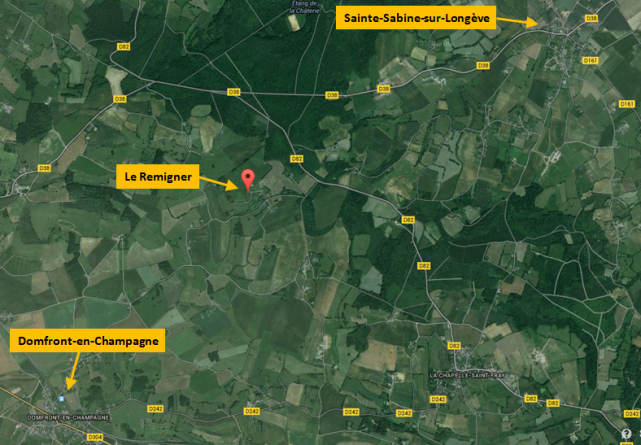
Aston fut conduit ensuite par une ambulance allemande à l'hôpital du Mans. Le 30 janvier, il fut conduit dans des baraques, interrogé par la Gestapo puis placé en détention. Le 1er février, il fut escorté en train à Paris, voyage au cours duquel il fut informé de la mort de Fielding et de son enterrement au Mans. Le 2 février, il fut escorté en train à Francfort, interrogé puis enfermé. Le 18 février, il fut transféré dans un camp de transit pour prisonnier à Francfort et reçut son premier colis de la croix rouge. Le 20 février, il fut emmené en train au camp de Sagan, le Stalag Luft III, un camp de prisonniers pour aviateurs, situé en Basse Silésie (aujourd'hui Żagań en Pologne).
Aston was then taken by German ambulance to Le Mans hospital. On January 30, he was taken to barracks, interrogated by the Gestapo and placed in confinement. On February 1, he was escorted by train to Paris, and was informed during the trip that Fielding had been killed and was buried at Le Mans. On February 2, he was escorted by train to Frankfurt, interrogated and placed in confinement. On February 18, he was escorted to transit P.O.W. camp at Frankfurt and received his first red cross parcel. On February 20, he was escorted to the camp of Sagan, the Stalag Luft III, a camp dedicated to airmen, located in Low-Silesia (today Żagań in Poland).
William (Billy) George ASTON
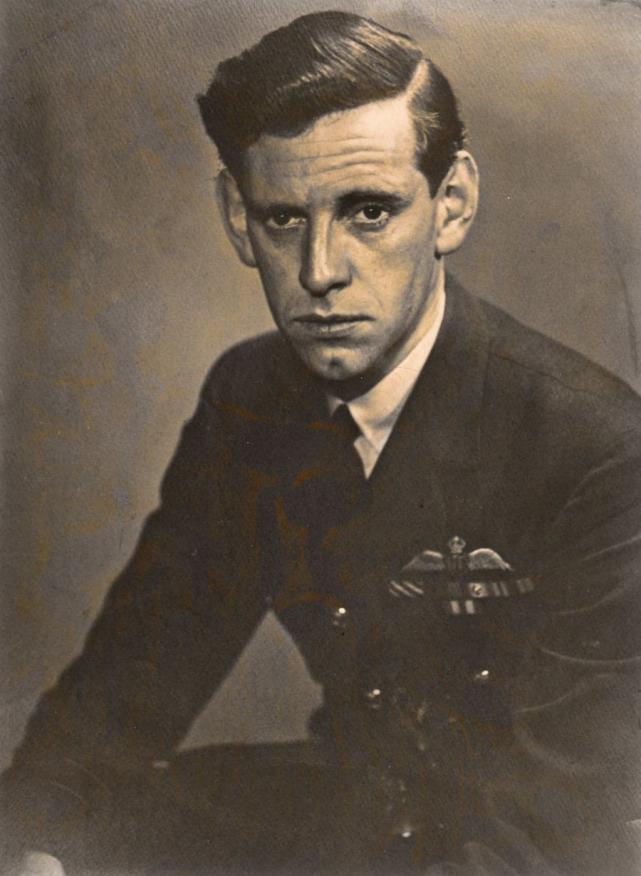
Source B.G. Aston Logbook © Marc Aston
Après la guerre, B.G. Aston devint dans les années 50 pilote d'essai chez Vickers Armstrong Ltd. J'ai peu d'information sur cette période mais je sais qu'il pilota un des 5 Vickers Valiant Type 674 de preproduction. Lors d'un vol en altitude moyenne notamment, ses deux ailerons se brisèrent à grande vitesse mais Aston réussit remarquablement à ramener l'avion à Boscombe Down.
After the war, B.G. Aston became test pilot in the fifties at Vickers Armstrong Ltd. I have only a few information about this period but I know that he flew one of the 5 pre-production Vickers Valiant Type 674. During a flight at medium altitude, both of his ailerons broke away at high speed but Aston remarkably brought the aircraft back to Boscombe Down.
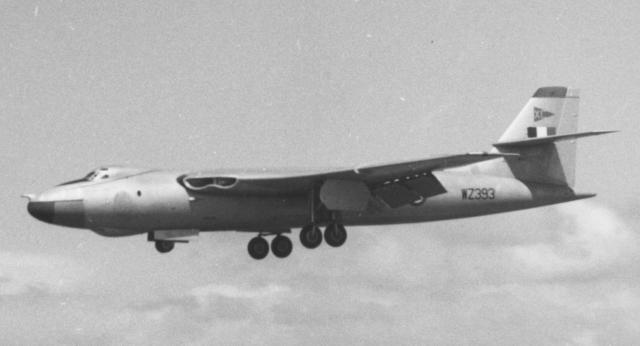
Vickers Valiant B1 © Ruth AS - source Wikimedia Commons
Pour cet acte de courage, B.G. Aston fut décoré de la Médaille de Georges.
For this act of bravery, B.G. Aston was awarded with the George Medal.
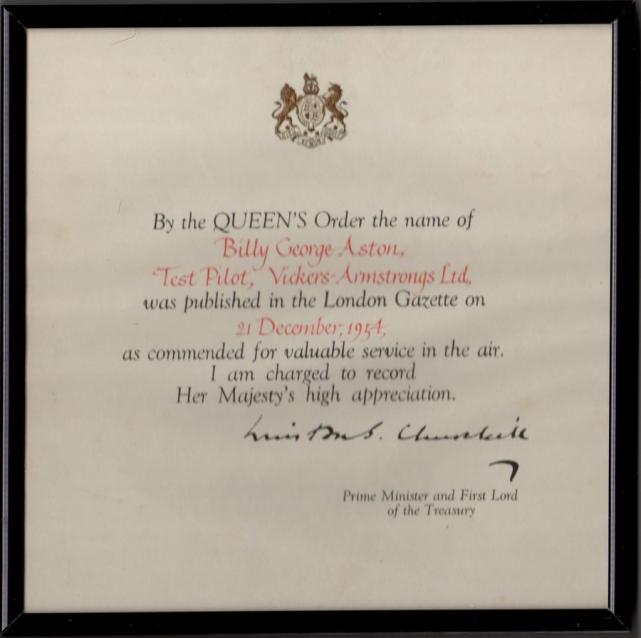
Source B.G. Aston Logbook © Marc Aston

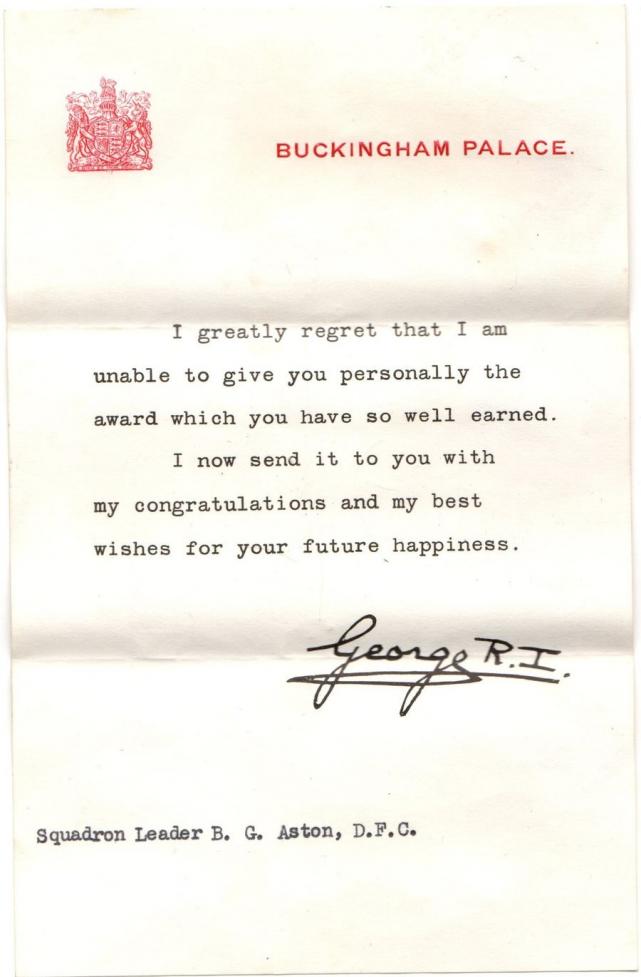
Source B.G. Aston Logbook © Marc Aston
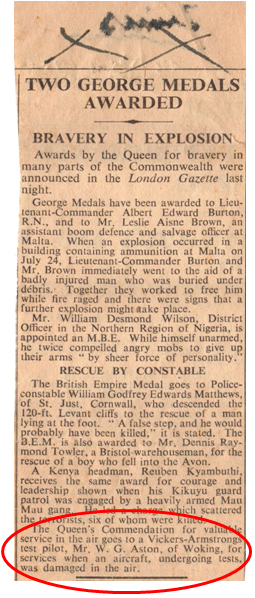
Source B.G. Aston Logbook © Marc Aston
Ci-dessous les ailes R.A.F. de B.G. Aston et la boîte de sa Distinguished Flying Cross (D.F.C.).
Here below B.G. Aston R.A.F. wings and the box of his Distinguished Flying Cross (D.F.C.).
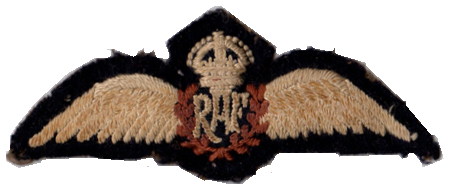
Source B.G. Aston Logbook © Marc Aston
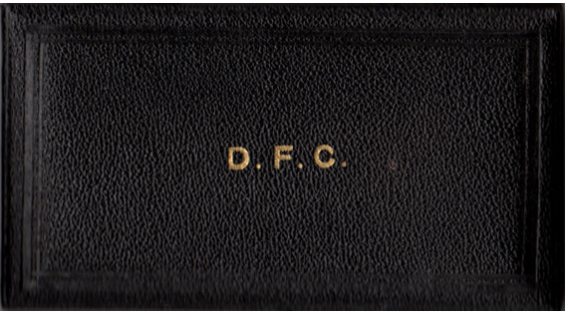
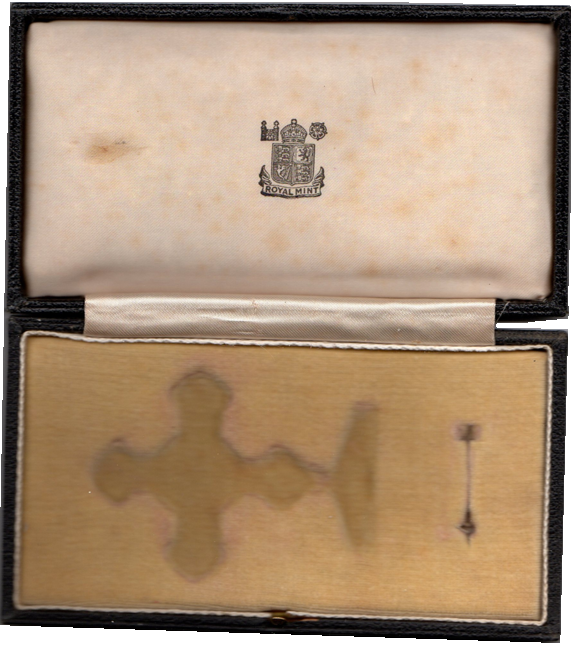
Source B.G. Aston Logbook © Marc Aston
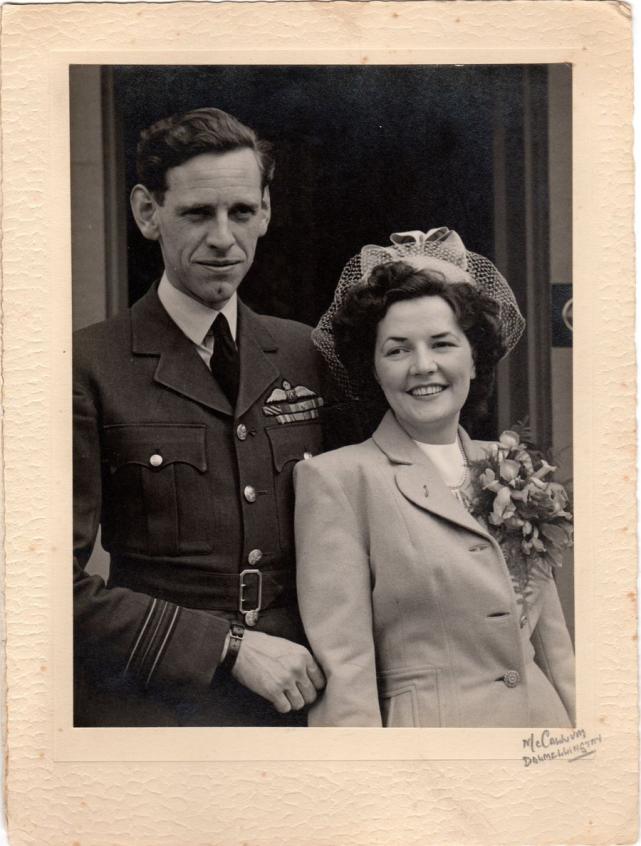
Mr and Mrs Aston
Source B.G. Aston Logbook © Marc Aston
Jacky Emery cultive le souvenir
Jacky Emery develops memory
2004 : le témoignage de Jean Bouland
2004 : Jean Bouland's testimony
Jacky Emery est un Sarthois qui recense les combattants mort en Sarthe pendant la seconde guerre mondiale. C'est donc tout naturellement qu'il s'est intéressé à Peter Samuel Fielding et Billy George Aston. Ses recherches l'auront conduit à interroger des témoins de l'époque comme Jean Bouland, moins de 10 ans en 1944, et dont le témoignage fut publié dans un article de Ouest France le 2 février 2004. Natif de Tourcoing, Jean Bouland avait fuit le Nord dès le début du conflit et arriva à Domfront-en-Champagne chez un oncle en 1943. C'est à l'initiative de MM. Bouland et Emery qu'une plaque commémorative fut posée près du monument aux mort de Domfront -en-Champagne.
Jacky Emery, living in Sarthe (western France) spends his time to look for combatants who died in Sarthe during the Second World War. It is then quite naturally that he was interested by the story of Peter Samuel Fielding and Billy George Aston. His investigation led him to meet several witnesses such as Jean Bouland, less than 10 years in 1944, whose testimony was published in an article of Ouest-France on February 2nd, 2004. Born in Tourcoing, Jean Bouland left the North of France at the beginning of the war and arrived at Domfront-in-Champagne in an uncle in 1943. Thanks to Mr Bouland and Mr Emery, a commemorative plaque was put close to the war memorial of Domfront-en-Champagne.

La tombe de P.S.A. Fielding au cimetière du Mans Ouest
The grave of P.S.A. Fielding at Le Mans Western Cemetery
2014 : la célébration des 70 ans !
2014 : celebrating the 70 years !
Toujours en quête d'informations sur le crash du Mosquito le 29 janvier 1944, Jacky Emery a fait publié un article souvenir dans le journal Ouest France du 29 janvier 2014.
Always looking for information on the crash of the Mosquito on January 29th, 1944, Jacky Emery made published an article to remember this event in the newspaper Ouest-France on January 29th, 2014.
